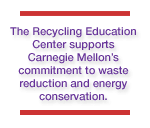What started out to be simply a place to recycle bottles and cans has been transformed into an inspirational Recycling Education Center for the Carnegie
Mellon community.
Established on Earth Day, April 22, 2001, in the University Center, the Recycling Education Center is a one-stop shop for recycling news and information. The light green-colored entranceway to the University Center off the Cut contains two computer kiosks that provide information about recycling processes and locations for recycling various materials. In addition to bins for bottles and cans, there are bins to collect old transparencies, CDs, cardboard, office paper, newspaper and plastic bottles.
The educational component of the center includes a brochure rack on the wall, where copies of "the green scene," the Green Practices Committee newsletter, and a constant supply of new environmental flyers and booklets can be found.
"We're trying to practice what we preach in our day-to-day operations," said Barb Kviz, environmental coordinator for Facilities Management Services and
co-chair of the Green Practices Committee, a group of about 20 faculty, staff and students committed to educating the university community about waste reduction and energy conservation practices.
"I've received a lot of positive feedback about the center," she said. "People enjoy looking at the kiosk and feel inspired by the artistic manner in which the space was designed."

Kviz said the university is currently recycling 15 percent of its waste products (by weight), but the goal is 25 percent. "Each individual can really make a difference," she said.
The center was the idea of Alexys Hanczar, a 2002 industrial design graduate, who as a senior, was a recycling intern for Kviz.
It was Hanczar's vision to create a recycling system for the entire university and she started the process. She believed that the University Center was the perfect location to establish a space to educate the campus community about the environmental benefits of recycling.
The modest beginnings for the center grew larger when A23 — a design consulting firm in Shadyside owned and operated by 2001 School of Design graduates Ayaka Uchida and Roger Wei — was commissioned to help with the project. Uchida, a communications design major, and Wei, who majored in industrial design and business, are working with the Green Practices Committee on a communications campaign.
"We designed the center to educate the campus community and inspire the community in a different way," Wei said. "The whole idea is about educating the community."
Around the top of the center are phrases aimed at encouraging the university community to reduce waste by recycling. The phrases include "Knowing is not enough; we must apply," and "Willing is not enough; we must do."
The Recycling Education Center is one of several environmental initiatives at the university. Green design principles are being used in the construction of the new residence hall on Morewood Avenue, which will be an energy- and water-efficient building that conserves materials and resources, minimizes harmful effects to the environment and maximizes living conditions. The facility will be the first building on campus and one of the first residence halls in the country to be certified by the Leadership in Energy and Environmental Design Green Building Rating System.
The university has extended its commitment to wind energy for five more years. Wind energy will make up six percent of the university's total electricity use through 2007. Carnegie Mellon was the first university in Pennsylvania to purchase wind power in 2001, and today there are 25 colleges and universities in the state buying wind-generated power, the most in the nation.
Carnegie Mellon participates in the Department of Energy Clean Cities initiative and has obtained three natural gas vehicles. Two are used by Facilities Management Services and a third is a cruiser for University Police. The plan is to acquire more low-emission vehicles in the future as older vehicles
are replaced.
The Green Practices Committee recently submitted a proposal for $100,000 to the Department of Environmental Protection Agency for a Green Roof Project in collaboration with Facilities Management Services and the Department of Electrical and Computer Engineering. The committee hopes to secure funding to create a plant-filled gathering place for the university community on the roof of Hamerschlag Hall.
For more on the Green Practices Committee, visit the Web at www.cmu.edu/epc.
Bruce Gerson
(10/10/02)